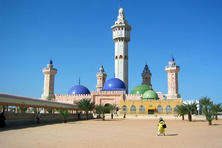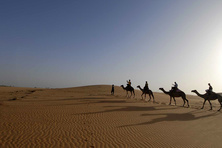Senegal
- Currency: West African CFA franc
- Time: UTC+0
- Languages: French
- Religions: Islam (Sunni)
- Sections: Get in Visa Customs Cuisine Money Details of interest Popular resorts
The Republic of Senegal is a state in West Africa. It is washed by the waters of the Atlantic Ocean. Senegal shares its borders with Mauritania, Guinea-Bissau, Mali, and Guinea. The capital city is Dakar. Another country, the Gambia, is almost completely surrounded by Senegal.
The climate in Senegal does not vary much throughout the year. The average temperature is +23°C - +28°C. Rains more frequently occur in the south of the country than on the north. A wet season is from July to October. A dry season is from November to April. During a dry season harmattan often occur, These is a dry and dusty north-easterly trade wind which blows from the Sahara Desert. The most comfortable time for visiting Senegal is from November to February.
About 20 African ethnic groups live in the country. The largest group is the Volofs. The official language is French, but the indigenous people speak local African dialects. The majority of the population are the Sunni Muslims.
During the last years, all types of active tourism are actively developing in Senegal from diving and exotic fishing to ornithological tours. The lovers of beach holidays should visit Sali with its popular resort Petit-Cote. If you love extreme tourism, take a trip to the Lompul desert.
In Senegal, the tourists can see the ancient monuments of colonial civilisation in the oldest cities of the Republic Saint-Louis and Ziginchor.
The Gambia River passes through the city of Kedougou and here, ecological tourism is developing.
The capital city Dakar is known as the starting place of the Dakar-Paris race. In this city, there are also wonderful beaches such as Les Almadies Beach and the Bel-Air Beach.
Markets are another sight of the country. The Kermela Market was built in 1860. Visit the largest national park Niokolo-Koba covering the territory of 11.000.000 Ha.
Get in
By Plane
The CIS tourists have to take a transit flight to Senegal with a transfer in Europe. Air France and Air Senegal offer the most convenient routes.
By Train
The travellers can get to Dakar from Bamako by train and the journey will take about 32 hours. The trains often come 8-10 hours late.
By Sea
One can get to Dakar by sea from the Canary Islands, Portugal, Gambia, and Morocco. There is a port in Saint-Louis.
By Land
The tourists can get to Senegal by car or by international bus from neighbouring countries.
Visa
The CIS and EU tourists can apply for a visa online without visiting the Embassy of Senegal. The applicant will receive a visa by e-mail.
One will have to scan a valid international passport to apply for a visa online.
You can also pay the visa fee online or on arrival at the airport of Senegal.
Customs
Make sure you know the Customs rules of Senegal to avoid any problems when entering the country.
The import of national and foreign currency is not limited, but the money must be declared. The export of national currency is limited to 20.000 XOF and foreign currency to 50.000 XOF.
Adult tourists can bring in cigarettes, alcohol, perfume, food and personal belongings. One photo and video device per person can be imported to Senegal.
The total cost of imported gifts must not exceed 5.000 XOF.
The tourists are not allowed to export ivory products, skins of rare animals, and stuffed rare animals.
Pets can be brought in provided there is an international vet certificate and a chip.
To export silver goods and handmade textile, the tourists must obtain an official permission of the authorities.
Cuisine
The Senegalese cuisine is considered to be the best on the African continent. The main ingredient here is rice and they add it to almost all dishes. The next popular foods are corn, millet, and sorgo.
The tourists should not leave Senegal without trying Ceebu Yapp, the most loved by the Senegalese rice, meat and vegetables stew with tomato sauce. Everyone should try amazing Senegalese sauces. Here the sauces are normally consumed by themselves. For example, Roff (garlic and onion sauce with bay leaves) and Bouye (a thick sauce from baobab leaves).
On the south of the country, people grow the pigs. However, in this Muslim country pork is not popular. Beef and mutton are imported so meat delicacies are quite expensive.
Try Ceebu Yapp (chicken with rice) and Maffe (meat stewed in coconut and peanut sauce). On the south of Senegal, you will be offered Cochon-de-lait-au-four (roasted whole pig).
Fish and seafood take a special place in the Senegalese cuisine. They boil, roast, bake, and stuff them in a European style.
The vegetables are used mainly as a side dish. The salads are not popular here. In Senegal, you can try unusual appetizer – unripe fruits generously seasoned with salt and pepper. The locals typically dress salads and vegetable appetizers with peanut butter.
The most famous Senegalese dessert is Lakh (sweet porridge with fruits). On the base of this porridge, the Senegalese make Ngalakh (sweet flatbread with porridge, baobab fruits, milk, and peanut butter).
The Senegalese drink green tea with mint and strong coffee with clove and pepper.
Money
The West African Franc (XOF) is the official currency in Senegal. US dollars and Euro are also accepted in the country.
The tourists can buy the currency at large banks or at the airport Dakar-Yoff.
We recommend taking traveller’s checks in Euro or US dollars. One can cash the checks at banks in large cities.
Credit cards are accepted in large cities, but if you pay with the card, a 5% commission will be charged.
There are ATMs almost in every city in Senegal.
Details of interest
The Senegalese use a very complicated system of gestures and signs showing the social status of a person. As there are many ethnic groups living in Senegal, make sure you know their traditions.
Baobab is a very important tree for the locals. You cannot cut or climb it without a special permission.
Sightseeing in Senegal
In Senegal, there are a lot of national parks and the largest of them is Niokolo-Koba which under UNESCO protection. Djoudji National Bird Sanctuary and a popular touristic place the Island of Goree are also inscribed on the UNESCO World Heritage List.
Another UNESCO site and the oldest island city in Senegal is the Island Saint-Louis. On the island, there is the Church of Saint-Louis en l’Isle built by the French architect Francois Le Vaut. The city still preserved colonial buildings and a unique Muslim cemetery.
The Stone Circles of Senegambia and the Saloum Delta are also under UNESCO protection. Take a trip to Kedougou to learn more about the people of Bassari, Fula, and Bedik.
In Dakar, there is the Senegal Historical Museum and the Senegal Maritime Museum. You will find the collection of unique musical instruments, sculptures, and masks from the entire West African region in the IFAN Museum.
A trip to the Retba Lake will be an unforgettable experience. Bacteria living in the lake can change its colour from pink to all the hues of brown. Not far from Retba, there is the Turtle Beach.
The city of Kaolack is known as the ‘capital of peanuts’. It is known for its huge baobab Gueye-Ndiuli and the ruins of the Saloum Kingdom and the Xing Kingdom.
Souvenirs of Senegal
In Senegal, you can buy funny and unusual souvenirs. Almost in any village, the tourists can buy traditional crafts. The city of Ziginchor is known for its metal goods and the cheapest market in the world Macrhe Saint-Maur. The tourists will find there coral jewellery, paintings, and woven furniture.
You can buy the Senegalese wine and liqueur in the Waranga village. Buy shea butter or mango vinegar.
An elegant gift for a woman is the Senegalese batik.
You can buy the symbol of Senegal, a miniature baobab.
On any market, you will find traditional Senegalese souvenirs such as tamtam, masks, wooden crafts and silver goods.












